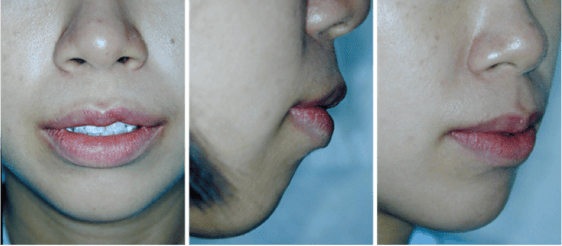Share this
Bimaxillary protrusion corrective jaw surgery without orthodontics
on July 7, 2016

Bimaxillary protrusion is a condition whereby the tooth-bearing parts of both the upper and lower jaws are positioned further forward than the base of the jaws. It is not strictly speaking a deformity unless it is excessively developed. In fact it is within the ethnic norm for Chinese and Malays. Nevertheless, many patients seek treatment for it as the societal norm now is that a straighter profile is considered more aesthetic. For most patients, orthodontic treatment with extraction of premolars will suffice. Those with more pronounced protrusion will require surgery to achieve the results that they want. However, there is a group of patients who do not want to have orthodontics as their jobs do not allow them to have orthodontic brackets bonded to their teeth for two to three years. Can they have corrective jaw surgeryto treat their bimaxillary protrusion without orthodontics?
In general, orthognathic surgery should always be done in conjunction with orthodontics because the movement of the jaw segments is too imprecise to achieve an proper alignment and bite. Without a proper alignment and bite, there may be instability to the results of the surgery because the segments may shift without the benefit of a definitive occlusion.
However, many patients with bimaxillary protrusion have very good occlusion to start with. The teeth are well aligned and straight. They seek treatment primarily to effect a change of facial appearance. For this group, while it is not ideal, it is possible to surgically correct the bimaxillary protrusion without orthodontics.
Without orthodontics, the surgical planning needs to be much more precise as there is no fine tuning of the occlusion postoperatively. Typically, surgical correction of bimaxillary protrusion consists of the following procedures:
- upper jaw:
- extraction of the first left and right premolars
- Le Fort I osteotomy (detaching the upper jaw from the rest of the skull)
- Segmentalization (dividing the upper jaw into four parts)
- Setting the front segments backwards to take up the space left by the extracted premolars
- lower jaw
- extraction of the first left and right premolars
- Hofer osteotomy (detaching the front part of the tooth-bearing portion of the lower jaw from the base
- Repositioning the detached front portion backwards to close up the space left by the extracted premolars
- Genioplasty: cut the chin and reposition it forward
All the segments are fixed in their new positions using titanium plates and screws. This allows rigid fixation of the segments three-dimensionally and that enables the patient to eat soft diet right from the first postoperative day.
Sometimes, temporary fixation screws are placed into strategic locations in the jaw for attachment of elastics postoperatively. These are mini rubber bands that when connected to these screws can be used to finetune the position of the segments that may be pulled slightly out of alignment by muscle attachments.
Multi-segment jaw surgery is more time consuming compared with full arch surgery as the occlusion needed to be fitted for each segment. Consequently, recovery will take a bit longer as well. However, the extra recovery time of a few weeks is short compared with the orthodontic treatment duration. Ultimately, it is best to have orthodontic in conjunction with surgery to achieve an ideal result.
Share this
- Jaw Surgery (93)
- Dental Implants Singapore (90)
- Orthognathic Surgery (48)
- Replacing Missing Teeth (26)
- Missing Teeth Options (23)
- Underbite (23)
- Bone Grafting (21)
- Costs (18)
- Facial Aesthetics (18)
- Aesthetics (17)
- dental implants (16)
- corrective jaw surgery (15)
- BOTOX (11)
- Dermal Fillers (11)
- Wisdom teeth (10)
- Fixed Implant Dentures (8)
- Loose Dentures Singapore (6)
- Medisave (6)
- sleep apnea (6)
- Braces (5)
- Dental Pain (5)
- Dentures in Singapore (5)
- Loose Teeth (5)
- Tooth Extraction (5)
- jaw deformities (5)
- bimax (4)
- bone graft (4)
- maxillomandibular advancement (4)
- all-on-4 (3)
- bimaxillary protrusion (3)
- chin implant (3)
- facial asymmetry (3)
- full mouth dental implants (3)
- genioplasty (3)
- immediate implant (3)
- removal of an integrated dental implant (3)
- third molars (3)
- wisdom tooth surgery (3)
- My Dentures Don't Fit (2)
- VME (2)
- bone graft healing (2)
- distraction osteogenesis (2)
- medical tourism (2)
- obstructive sleep apnea (2)
- orthodontics (2)
- plastic surgery (2)
- CT guided dental implants (1)
- Double jaw surgery (1)
- Invisalign (1)
- Periodontal Disease (1)
- Permanent Dentures Singapore (1)
- before and after photos (1)
- facial trauma (1)
- fractured dental implant (1)
- oral appliance therapy (1)
- root canal treatment (1)
- veneers (1)
- vertical maxillary excess (1)
- September 2019 (2)
- July 2019 (2)
- May 2019 (2)
- August 2018 (1)
- October 2017 (1)
- September 2017 (2)
- August 2017 (1)
- June 2017 (2)
- May 2017 (4)
- April 2017 (1)
- March 2017 (1)
- February 2017 (3)
- January 2017 (3)
- December 2016 (1)
- November 2016 (2)
- October 2016 (4)
- September 2016 (9)
- August 2016 (5)
- July 2016 (11)
- June 2016 (14)
- May 2016 (6)
- April 2016 (2)
- March 2016 (1)
- January 2016 (7)
- December 2015 (10)
- November 2015 (4)
- October 2015 (9)
- September 2015 (7)
- August 2015 (1)
- July 2015 (6)
- June 2015 (3)
- May 2015 (7)
- April 2015 (5)
- March 2015 (8)
- January 2015 (5)
- December 2014 (7)
- November 2014 (7)
- October 2014 (6)
- September 2014 (8)
- August 2014 (5)
- July 2014 (7)
- June 2014 (8)
- May 2014 (9)
- April 2014 (10)
- March 2014 (6)
- February 2014 (8)
- January 2014 (3)
Subscribe by email
Email subscription




Comments (3)